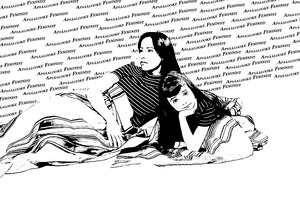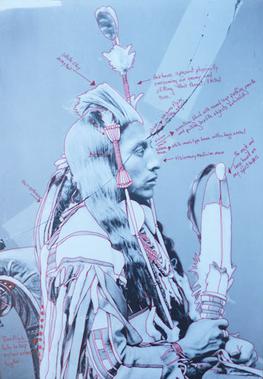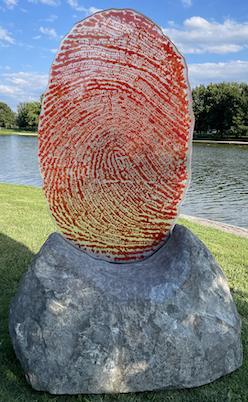Wendy Red Star facts for kids
Quick facts for kids
Wendy Red Star
|
|
|---|---|

Red Star, left, pictured in her work Ashkaamne (matrilineal inheritance) (2019)
|
|
| Born | 1981 (age 44–45) Billings, Montana, United States
|
| Education | Montana State University Bozeman, BFA University of California Los Angeles, MFA |
| Known for | Photography, installation, sculpture |
| Awards |
|
Wendy Red Star (born 1981) is a modern artist from the Apsáalooke (Crow) Nation. She was born in Billings, Montana, in the United States. Wendy uses humor and traditional Native American images in her art. She wants people to think about how Native Americans are shown in popular culture. Her art often mixes old ideas with new ones. It shows real cultural and gender identities. People have called her work "funny, brave, and dreamlike." In 2024, Wendy Red Star received a special award called a MacArthur Fellowship.
Contents
About Wendy Red Star
Early Life and Education
Wendy Red Star was born in 1981 in Billings, Montana. She is part Apsáalooke (Crow) and part Irish. She grew up in Pryor, Montana, on the Crow Reservation. This place is a sovereign nation and has a strong culture.
When she was 18, Wendy left the reservation. She went to Montana State University - Bozeman from 2000 to 2004. There, she studied art and Native American Studies. Later, she earned a Master of Fine Art degree in 2006. This was from the University of California, Los Angeles.
Growing up, Wendy sometimes felt confused about her mixed background. She learned to be proud of her identity. This pride became a big part of her artwork. She often thinks about her childhood and where she grew up.
Her mother was a nurse who supported Crow culture. Her father was a rancher and a pilot. He also played in an Indian rock band. Wendy's uncle, Kevin Red Star, and her grandmother, Amy Bright Wings, were important to her art.
Her Art Journey
Wendy first focused on sculpture in college. But her art now includes many different types. She creates photography, fashion design, bead work, and painting. She also does fiber art and performance art.
From 2012 to 2013, she worked at Chief Plenty Coups (Alek-Chea-Ahoosh) State Park and Home. In 2014, she moved to Portland, Oregon. Since 2016, she has been a full-time artist. She has also given talks at famous universities. These include Yale University and Brown University.
Wendy Red Star's Art
Wendy Red Star uses many different art forms. Her work often includes common ideas about Native Americans. She also explores colonialism, the environment, and her own family. Her art layers influences from her Crow background. It also uses everyday things and history.
She often uses humor in her art. She might add inflatable animals or fake scenery. This helps her talk about serious topics in a fun way. In her photos, Wendy often wears traditional elk-tooth dresses that she makes herself.
Her art has been shown in major museums. These include the National Museum of the American Indian and the Metropolitan Museum of Art.
Important Art Series
Thunder Up Above
In this series, Wendy created a special costume. It mixed European and Native American styles. She then added a space background to her photos. The art makes you think about meeting new people. It shows someone you would not want to mess with.
Four Seasons
For her Four Seasons series, Wendy makes fun of old ideas. These ideas often show Native Americans as being "one with nature." She poses with blow-up deer and fake mountains. This helps her challenge common beliefs. The Saint Louis Art Museum owns this series.
White Squaw
Wendy researches old Hollywood images. She found old books and movies with the title White Squaw. She took photos of these book covers. Then, she put her own picture in a cheap costume where the "White Squaw" character was. She kept the original words from the covers. This made the art funny and satirical.
1880 Crow Peace Delegation

In 1880, six Crow chiefs went to Washington, D.C. They talked to the president about settlers building a railroad. Wendy researched one of these chiefs, Medicine Crow. She used a red pen on a famous photo of him. She wrote notes about his clothes and what they meant. She wanted to show Medicine Crow as a real person.
Circling the Camp
Wendy took photos at the Crow Fair. This is a big yearly event in Montana. She removed the backgrounds from her pictures. This made the focus only on the Indigenous people and objects. It highlights their culture and history.
Apsáalooke Feminist
Most old photos of Crow women are in black and white. Wendy took colorful photos of herself and her daughter, Beatrice. They wore bright Crow clothes. This shows the everyday fashion of Crow people. She added patterned backgrounds to make the images stand out.
My Home is Where My Tipi Sits
This series shows grids of photos from Crow reservations. It includes government houses, old cars, and churches. The art is like the work of German photographers Bernd and Hilla Becher. They would photograph industrial buildings in grids.
Let Them Have Their Voice
This art piece responds to a book from 1908. The book was called The North American Indian. Wendy changed the portraits in the book. She made the Native people into dark shapes. But she added sound recordings of Crow singers. This makes the people feel present again.
The Soil You See...

In 2023, Wendy created art for the National Mall in Washington, D.C. It was part of the first art show there. She designed a memorial for Apsáalooke leaders. These leaders had signed treaties with the United States. The sculpture is a red glass fingerprint on a granite rock. It lists the names of the Apsáalooke leaders. It is placed near the memorial for the signers of the Declaration of Independence.
Working with Others
In 2013, Wendy started working with her daughter, Beatrice Red Star Fletcher. Beatrice is often in Wendy's art. She also helps as a tour guide for their shows. Their joint works have been shown in several museums. These include the Tacoma Art Museum and the Seattle Art Museum.
In 2022, Wendy worked with Stanford University. Her project, Wendy Red Star: American Progress, explored her experiences as an Apsáalooke artist in the United States. She worked with students to research and gather materials. This collaboration created public art. It helps people learn about Indigenous stories.
Selected Exhibitions
Wendy Red Star has shown her art in many places since 2003. Some of her exhibitions include:
- Parading Culture (Tokens, Gold and Glory) Haw Contemporary Fine Art Gallery, Kansas City, Missouri (2016)
- The Plains Indian: Artists of Earth and Sky: Metropolitan Museum of Art (2015)
- Peelatchiwaaxpáash/Medicine Crow (Raven) & the 1880 Crow Peace Delegation: APEX gallery, Portland Art Museum (2015)
- Circling the Camp: Wendy Red Star: Indianapolis Museum of Contemporary Art (2014)
- Crow Women's Objects. Saint Louis Art Museum, St. Louis, Missouri. (2014)
- My Home Is Where My Tipi Sits (Crow Country): Missoula Art Museum (2011)
- Wendy Red Star: A Scratch on the Earth. The Newark Museum of Art (2019)
- Wendy Red Star: Apsáalooke: Children of the Large-Beaked Bird, MASS MoCA, North Adams, MA (2020–2021)
Awards and Fellowships
- 2024 MacArthur Fellowship
- Joan Mitchell Foundation Emerging Artist Fellowship
- Eiteljorg Contemporary Art Fellowship
- 2017 Louis Comfort Tiffany Foundation
See also
- Native American women in the arts
- Visual arts by indigenous peoples of the Americas
- Indigenous Futurism


